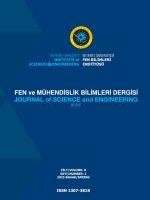TERSİNE LOJİSTİKTE DİJİTALLEŞMENİN KRİTİK FAKTÖRLERİ ÜZERİNE BİR ÇALIŞMA
Tersine lojistik veya kapalı döngü tedarik zincirleri, çevresel, sosyal ve ekonomik hususları içeren sürdürülebilir uygulamalara ulaşmak için günümüzün iş ortamında kritik bir rol oynamaktadır. Tersine lojistik, ömrünü tamamlamış ürünlerin son kullanıcılardan toplanmasını kapsar ve yeniden kullanım, yeniden üretim, geri dönüşüm, yenileme ve bertaraf gibi geri kazanım süreçleriyle devam eder. Bu faaliyetlerin çevresel ve sosyal konularda olduğu kadar şirketin ekonomik durumu üzerinde de önemli etkileri bulunmaktadır. Bu nedenle, kapalı döngü yapılar organizasyonlar için vazgeçilmez hale gelmekte ve tersine lojistik, tedarik zincirlerinin tartışılmaz bir unsuru haline gelmektedir. Endüstri 4.0 veya dijital çağ olarak adlandırılan endüstrideki hızlı dijitalleşme, sürdürülebilirliğe katkıda bulunmak için tersine lojistik operasyonlarını desteklemek ve geliştirmek için büyük bir fırsat olarak görülebilir. Sürdürülebilir uygulamalar ile dijital operasyonlar arasındaki ilişki hem uygulayıcıların hem de akademisyenlerin dikkatini çekmiş olsa da mevcut literatür, tersine lojistik faaliyetlerinde doğrudan dijitalleşme uygulamalarını kapsayan faktörleri sağlama konusunda yetersizdir. Buradan hareketle bu çalışma, öncelikle tersine lojistikte dijitalleşme için kritik faktörleri ortaya koymayı ve ikinci olarak bunları değerlendirerek pratik uygulamalar için bir önceliklendirme yapmayı amaçlamaktadır. Bu amaçlara ulaşmak için, öncelikle literatür tarafından desteklenen kritik faktörleri önermek için bir literatür taraması yapılacaktır. İkinci olarak, bu faktörleri önceliklendirmek ve en önemli kavramları ortaya çıkarmak için Bulanık Entropi Ağırlıklandırma Yöntemi kullanılacaktır. Çalışmanın sonunda yeni kavramlar sunarak ve sonuçlara dayalı olarak gelecek araştırma fikirleri önererek literatüre katkı sağlaması beklenmektedir.
Anahtar Kelimeler:
Reverse Logistics, Sustainability, Digitalization, Fuzzy-Entropy Weighting Method
A STUDY ON CRITICAL FACTORS OF DIGITALIZATION IN REVERSE LOGISTICS
Reverse logistics or closed loop supply chains play a critical role in todays’ business environment in order to achieve sustainable practices that include environmentally, socially and economic considerations. Reverse logistics covers the collection of end-of-life phased products from end users, and continue with recovery processes i.e. reuse, remanufacturing, recycling, refurbishment, and disposal. These activities have significant impacts on environmental and social issues as well as economic conditions of the company. Therefore, closed loop structures become essential for organizations, and reverse logistics becomes an indisputable element of the supply chains. Rapid digitalization in industry, so called Industry 4.0 or digital era, can be seen as a great opportunity to support and improve reverse logistics operations to contribute sustainability. Although, the relationship between sustainable practices and digital operations received the attention of both practitioners and academicians, the current literature lacks in providing factors that directly covers digitalization implementations in reverse logistics activities. From this point of view, this study, firstly, aims to propose critical factors for digitalization in reverse logistics, and secondly evaluate them to make a prioritization for practical implementations. To achieve these aims, initially a literature review will be conducted to propose critical factors that are supported by the literature. Secondly, Fuzzy-Entropy Weighting Method is going to be used to prioritize these factors and to reveal the most important concepts. At the end of the study, it is expected to contribute the literature by providing new concepts and suggesting future research ideas based on the results.
___
- Agrawal, S., Singh, R. K. and Murtaza, Q. (2015). A literature review and perspectives in reverse logistics. Resources, Conservation and Recycling, 97, 76-92. https://doi.org/10.1016/j.resconrec.2015.02.009
- Dev, N. K., Shankar, R. and Swami, S. (2020). Diffusion of green products in industry 4.0: Reverse logistics issues during design of inventory and production planning system. International Journal of Production Economics, 223, 107519. https://doi.org/10.1016/j.ijpe.2019.10751
- Fofou, R. F., Jiang, Z. and Wang, Y. (2021). A review on the lifecycle strategies enhancing remanufacturing. Applied Sciences, 11(13), 5937. https://doi.org/10.3390/app11135937
- Gautam A. (2020), Transforming reverse logistics through the digital route. https://innoverdigital.com/transforming-reverse-logistics-through-the-digital-route/. Access: 09.10.2022
- Goodall, P., Sharpe, R. and West, A. (2019). A data-driven simulation to support remanufacturing operations. Computers in Industry, 105, 48-60. https://doi.org/10.1016/j.compind.2018.11.001
- Haque, K. F., Zabin, R., Yelamarthi, K., Yanambaka, P. and Abdelgawad, A. (2020, June 1). An IoT based efficient waste collection system with smart bins. IEEE World Forum on Internet of Things, WF-IoT 2020 - Symposium Proceedings. https://doi.org/10.1109/WF-IoT48130.2020.9221251
- Ighravwe, D. E. and Oke, S. A. (2017). A multi-hierarchical framework for ranking maintenance sustainability strategies using PROMETHEE and fuzzy entropy methods. Journal of Building Pathology and Rehabilitation, 2(1), 1-18. https://doi.org/10.1007/s41024-017-0028-7
- Kazancoglu, Y., Ozbiltekin-Pala, M., Sezer, M. D., Kumar, A. and Luthra, S. (2022). Circular dairy supply chain management through Internet of Things-enabled technologies. Environmental Science and Pollution Research, 1, 1-13. https://doi.org/10.1007/s11356-021-17697-8
- Krstić, M., Agnusdei, G. P., Miglietta, P. P., Tadić, S. and Roso, V. (2022). Applicability of Industry 4.0 technologies in the reverse logistics: A circular economy approach based on comprehensive distance based ranking (COBRA) method. Sustainability, 14(9), 5632. https://doi.org/10.3390/su14095632
- Panghal, A., Manoram, S., Mor, R. S. and Vern, P. (2022). Adoption challenges of blockchain technology for reverse logistics in the food processing industry. Supply Chain Forum, 24(1), 7–16. https://doi.org/10.1080/16258312.2022.2090852
- Sangwan, K. S. (2017). Key activities, decision variables and performance indicators of reverse logistics. Procedia Cirp, 61, 257-262. https://doi.org/10.1016/j.procir.2016.11.185
- Shah, S., Dikgang, G. and Menon, S. (2019). The global perception of industry 4.0 for reverse logistics. International Journal of Economics and Management Systems, 4, 103-107.
- Sun, Q. (2017). Research on the influencing factors of reverse logistics carbon footprint under sustainable development. Environmental Science and Pollution Research, 24, 22790-22798. https://doi.org/10.1007/s11356-016-8140-9
- Sun, X., Yu, H. and Solvang, W. D. (2022). Towards the smart and sustainable transformation of Reverse Logistics 4.0: A conceptualization and research agenda. Environmental Science and Pollution Research, 29(46), 69275–69293. https://doi.org/10.1007/s11356-022-22473-3
- Yan, X., Liu, W., Lim, M. K., Lin, Y. and Wei, W. (2022). Exploring the factors to promote circular supply chain implementation in the smart logistics ecological chain. Industrial Marketing Management, 101, 57-70. https://doi.org/10.1016/j.indmarman.2021.11.015
- ISSN: 1307-3818
- Başlangıç: 2007
- Yayıncı: Beykent Üniversitesi
Sayıdaki Diğer Makaleler
TERSİNE LOJİSTİKTE DİJİTALLEŞMENİN KRİTİK FAKTÖRLERİ ÜZERİNE BİR ÇALIŞMA
Türkiye’deki Akıllı Kargo Dolabı Uygulamaları
G.nilay YÜCENUR, Sena ÇALIŞKAN, Özge İRTEN, İlker ŞAHİN
TEDARİK ZİNCİRİ DİRENCİLİĞİNİ ARTIRMAK İÇİN DİJİTALLEŞME OLASILIKLARI VE SINIRLARI
Marc-andré WEBER, Peter D. FRANKE, Ulrike AUMUELLER
GERÇEK HAYAT AKTARMA PROBLEMİNE TAM ÇÖZÜM
